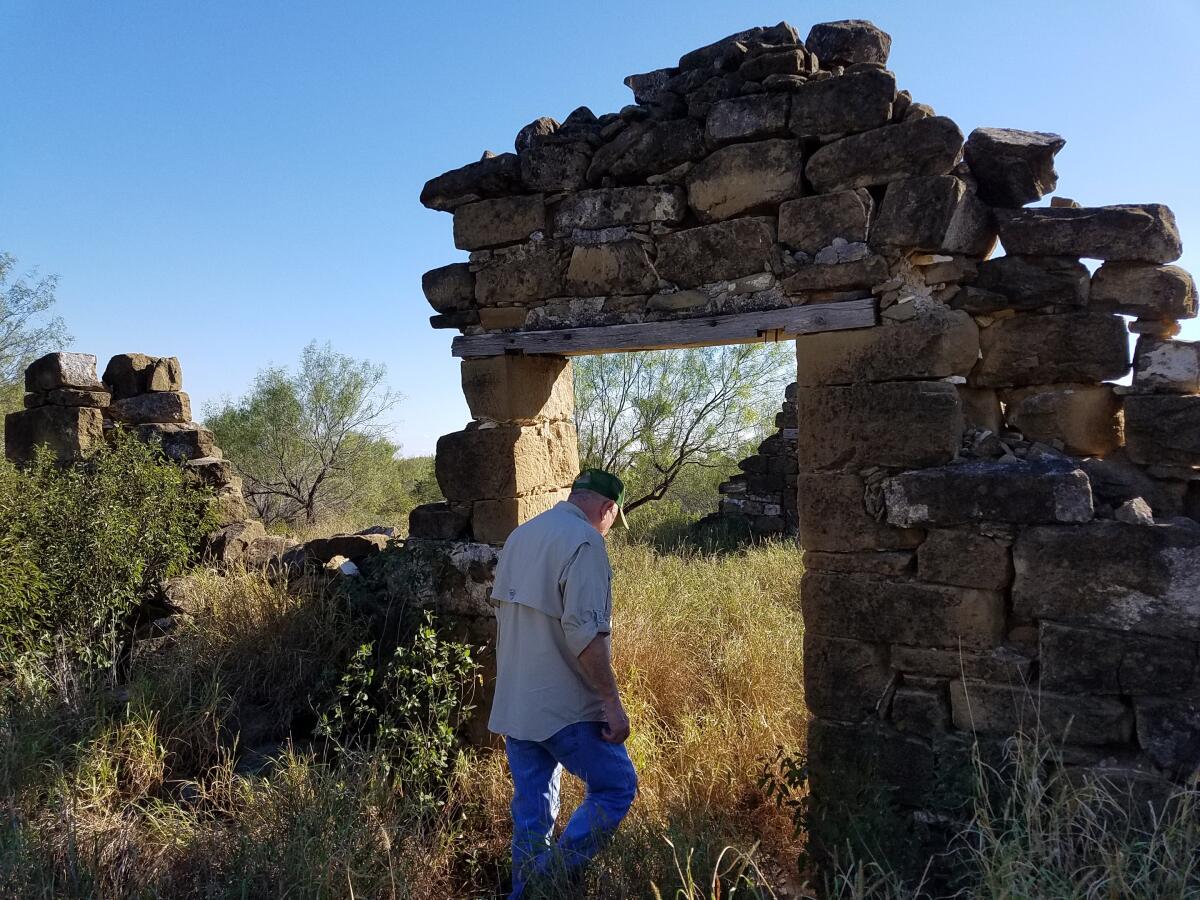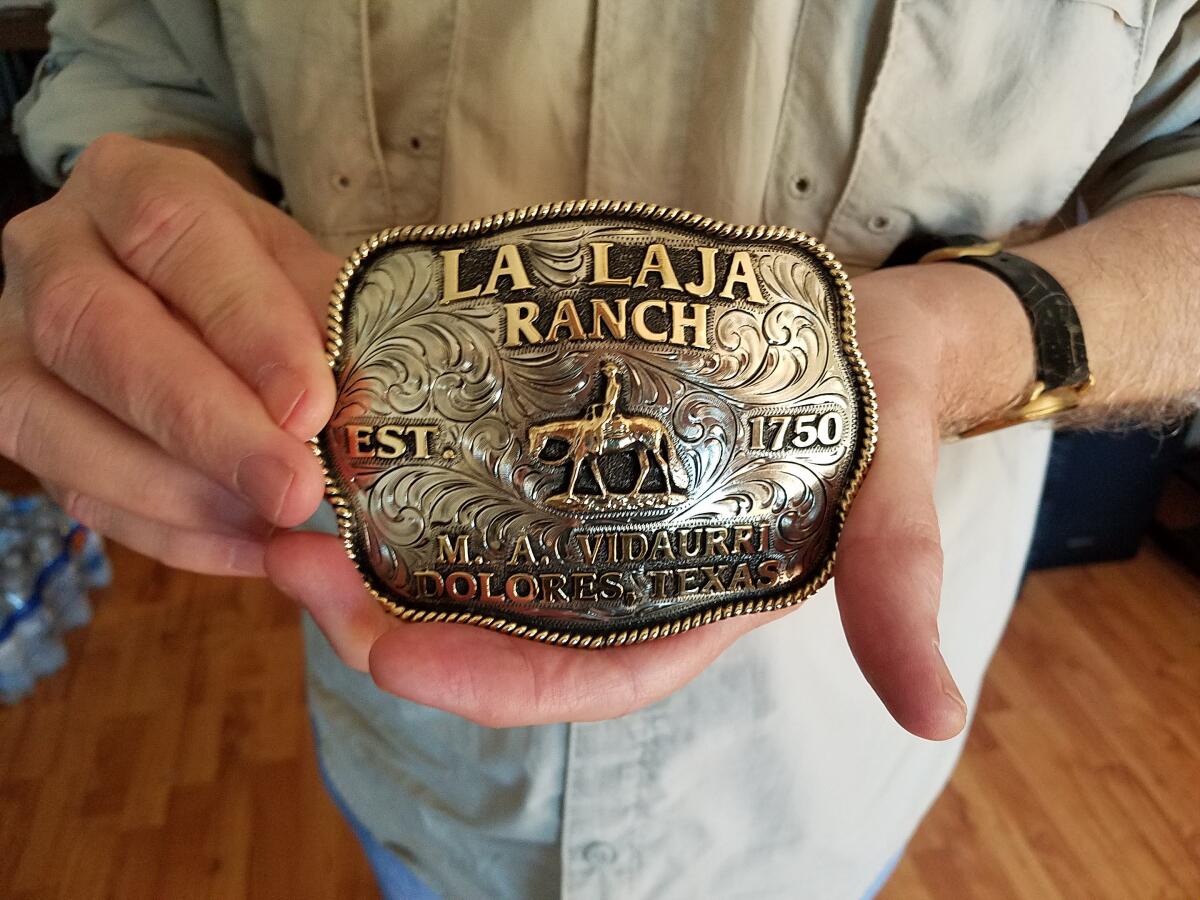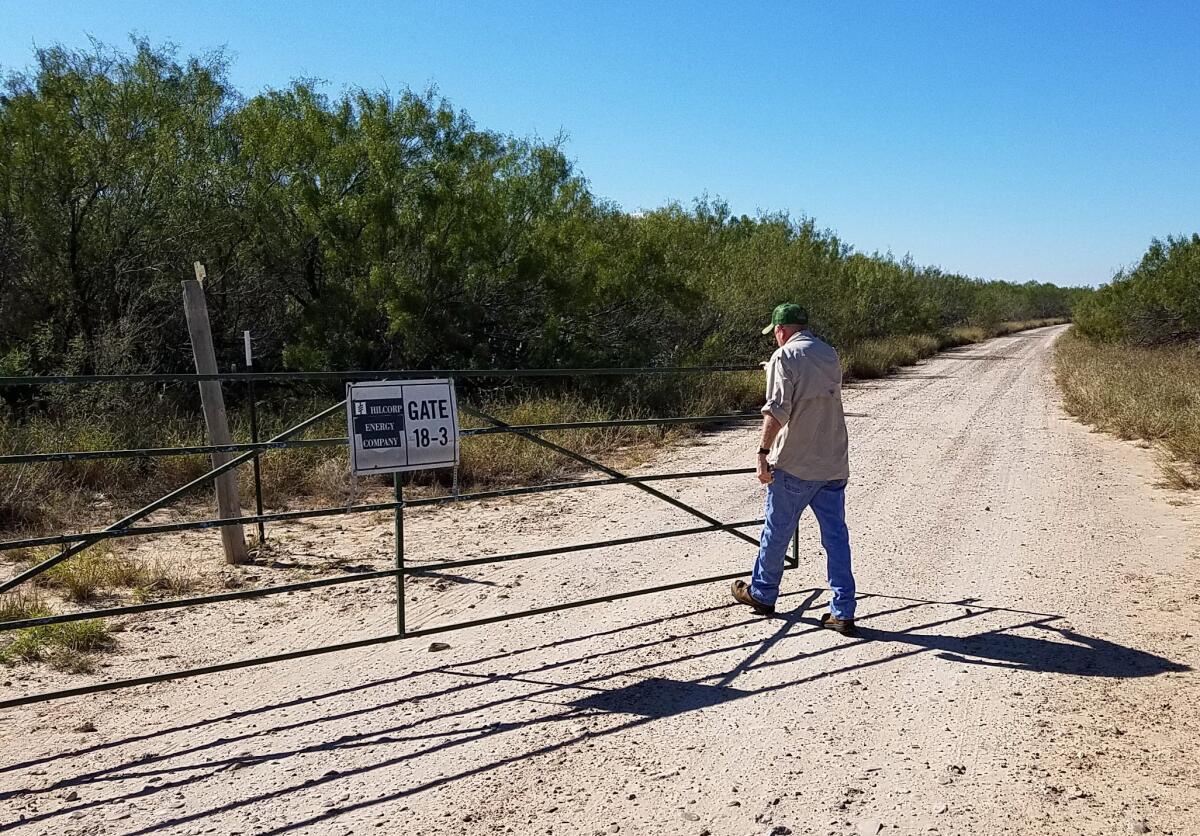Texas veteran’s family set to lose land to Trump’s wall: ‘Why should we sacrifice again?’

- Share via
DOLORES, Texas — It’s tough for Mauricio Vidaurri to imagine a U.S.-Mexico border wall cutting off access to scores of graves at the ranch his family has owned since 1750.
His father, a rancher and Marine who received a Purple Heart after being wounded at Iwo Jima during World War II, is among more than 110 relatives buried in the cemetery near the Rio Grande.
Vidaurri and his two brothers served in the military too, then worked a variety of jobs for U.S. Customs and Border Protection. Vidaurri retired in May, but a younger relative still works for the agency.
Now the family’s 1,300-acre property in rural Dolores is vulnerable to a Trump administration plan to build 500 miles of new border wall by the end of 2020. More than a hundred miles of that wall would be built in Texas, cutting across thousands of private parcels.

It isn’t clear where on the property the wall would be built. However, as in other parts of South Texas, it’s expected to be erected north of the river, which to Vidaurri feels like ceding land and water to Mexico. The Border Patrol has promised to be sensitive to property owners’ needs, but Vidaurri fears he will lose access to the cemetery and to the river water he relies on to irrigate his hay fields.
“It’s like going into Gettysburg or Bunker Hill and saying, ‘Let’s put a wall here.’ “It’s our history,” Vidaurri, 61, said last week. “When our nation has called, we have answered. Why should we sacrifice again?”
Attorneys working with residents warn they can do little to stop construction and will have to fight for fair compensation.
In February, President Trump declared a national emergency on the border, diverting $3.6 billion in Pentagon funding for the wall. Congress already had refused to allow the administration to spend more than $1.375 billion for it.
Last week, a federal judge in Texas ruled the president’s emergency proclamation unlawful and issued a nationwide injunction preventing the administration from using the Pentagon money. But the judge found it could tap into a separate $2.5-billion drug interdiction fund, allowing construction to proceed.
So far, the administration has had about 90 miles of border barrier built, mostly replacing existing fencing, according to a U.S. Army Corps of Engineers report this month. In October, the administration started building 13 miles of wall in Texas’ Rio Grande Valley, where it has issued contracts this year to build another 83 miles of wall. The government also began building 166 more miles of wall this year in border areas near Tecate, Mexico; El Centro, Calif.; El Paso; and Tucson and Yuma, Ariz.


The $3.6 billion in Pentagon funding at issue in federal court has been earmarked to build another 175 miles of border wall around El Centro, El Paso, San Diego, Yuma and Laredo, Texas — including on Vidaurri’s ranch.
The Border Patrol said in a statement this week that it is still “in the process of determining real estate requirements” for building portions of the border wall in the area of Vidaurri’s ranch. “These locations are not currently funded for real estate acquisition or new border wall system construction and the total number of miles is dependent on the amount of funding received,” it said.
The statement acknowledged that the agency and the Corps of Engineers are contacting property owners to survey their land. Border Patrol officials plan to contact landowners about historic sites in the path of the wall and will be “developing measures that will avoid or minimize impacts to these sensitive areas to the greatest extent possible,” the statement said.
Vidaurri’s family and other landowners have already received “right of entry” letters from the federal government seeking to survey their ranches, a first step toward taking the land through the legal process of eminent domain. In the past, many South Texas landowners have consented to such surveys and ultimately sold, often at a loss, according to Ricky Garza, an attorney at the nonprofit Texas Civil Rights Project who is helping Vidaurri and half a dozen others who have received the letters.
After the Secure Fence Act passed in 2006, partially funding 700 miles of new border fence, landowners in South Texas with savvy attorneys got the government to pay them millions for property in the path of new border fencing while others received far less.
“Some of the same concerns are going to play out with these takings,” Garza said. “It’s coming and it’s coming fast.”
By law, the government is required to offer fair compensation for the land, but they can seize it in as little as 90 days, giving owners very little leverage in negotiations, Garza said. Federal officials sometimes ultimately decide they can’t build but still keep the land.
“We probably are not going to be able to block the wall on anyone’s property. This is going to be a case of fair compensation,” Garza said. “There’s not a lot landowners can do because the law is so favorable to the government.”
The federal government this month filed its first land acquisition case to condemn about 13 acres in the Rio Grande Valley, offering the owner $93,449 — or about $7,200 an acre. The government has since filed two more federal lawsuits to condemn land where it plans to build the wall, according to court records, but the amount of compensation varied. The government offered one owner about $4,200 an acre for six acres, the other — a prominent local farmer — about $13,500 an acre for 23 acres.
The Vidaurri ranch was once 6,000 acres but has dwindled to 1,300 acres, divided among eight siblings. Last month, Mauricio Vidaurri’s sister Cynthia Silva received a right of entry letter. The family hired an attorney and so far has not agreed to let the government survey, Vidaurri said.
During his visit to the ranch last week, Vidaurri pointed out the ruins of a sandstone cabin where his father was born. The family named their ranch after that native sandstone, La Laja. Vidaurri has brought his three daughters and grandchildren to see the tool marks their ancestors made carving the stone.
His father, Roberto Vidaurri, taught him to brand cattle and shared his war stories: how he joined the Marines as a teenager, trained with the infantry at Camp Pendleton, was wounded in the leg on Iwo Jima before watching troops raise the U.S. flag on Mt. Suribachi. When he died three years ago, he was buried with a piece of Japanese mortar still in his leg.
“It really pains me that I can lose my father to a vanity wall,” Vidaurri said. “... It makes no sense when you have better technology.”

A registered independent, he supports the Border Patrol and has allowed its agents to traverse the ranch and install surveillance cameras and sensors. When smugglers broke into his father’s ranch house three years ago, agents helped chase them off. He would like to see more agents patrolling the area and doesn’t think a wall will deter illicit border crossings.
His family has also leased parts of the ranch to energy companies and hunters, and they’re not sure whether changes in those arrangements will come because of a wall.
Standing in the family cemetery, Vidaurri said he feels it’s his duty to fight the wall, just as previous generations defended the ranch against bandits, outlaws and revolutions.
“I just wouldn’t want my ancestors to say, ‘You didn’t do enough; this is our land, you didn’t take care of it,’” he said.
More to Read
Sign up for Essential California
The most important California stories and recommendations in your inbox every morning.
You may occasionally receive promotional content from the Los Angeles Times.











